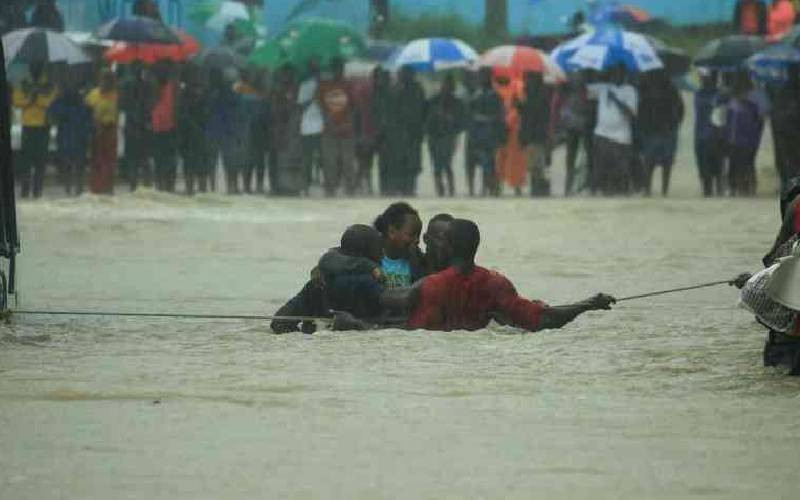NAIROBI: El Niño is not a new phenomenon. It occurred in 1997/98, causing loss of lives, animals and serious damage to property. Researchers say that El Niño, which essentially translates to heavy rains, is caused by changes in ocean temperatures that affect weather patterns around the globe.
There is approximately a 95 per cent chance that El Niño will continue through the Northern Hemisphere winter 2015/16, according to National Oceanic and Atmospheric Administration. Kenya lies on the Equator. Part of it is in the Northern hemisphere, while the other part is on the Southern Hemisphere, although it is largely on the Eastern Hemisphere.
This means, if not all parts of the country will experience El Niño, most parts that lie on the Northern Hemisphere will.
With barely a few days into October, when the onset of El Niño is expected, thorough disaster response preparedness among the public should be taking place.
The Sh5 billion set aside by the Government and thousands of National Youth Service personnel put on standby in readiness to respond to the occurrence is commendable. It is good to prepare for the worst.
The response would however be more effective and swift if the public is involved.
Sensitisation ‘barazas’ should already be taking place. Energetic, active and courageous persons from every ward need to be identified and taken through the disaster management process. The public needs to know what to do when they experience floods in the night or when their houses are covered in water. There are places like Nyando and Budalang’i that flood even during short rains.
In such places, rescue centres should have been identified and the residents notified so that in case of any emergency occurrence their safety is guaranteed. Twenty-four-hour, seven-days-a-week toll-free emergency line should be set up already.
The public should be in a position to report any urgent development resulting from the rains to enable fast response from the rescue team.
The national Youth Service members require communication gadgets so that their coordination with the Government, humanitarian organisations and other agencies is easy and prompt.
Ambulances and rescue helicopters need to be considered. For the ambulances, strong, four-wheel-drive vehicles are needed, which can maneuver through muddy areas. Anything can happen to El Niño victims. Setting aside emergency units within county and sub-county hospitals is necessary. To avoid inconveniences by striking doctors and nurses, a special group of medical practitioners should be identified. Floodwaters provide good breeding places for mosquitoes that cause malaria and Rift Valley Fever in human beings and animals.
The United Nations Food and Agriculture Organisation (FAO) says heavy rains in 1997/98 led to an outbreak of Rift Valley Fever that took several lives.
The Centres for Disease Control and Protection (CDC) also indicated that in late 1997, there was outbreak of Rift Valley Fever in East Africa. And in just three months, 90,000 people were reported sick with approximately 500 people dying.
Stay informed. Subscribe to our newsletter
The virus that causes the disease is transmitted by mosquitoes. The disease, which has no human vaccine, according to CDC, causes brain swelling, unusual bleeding or blindness as well as death. It can lead tomiscarriage in pregnant animals.
Teams of health personnel and vets should have been put together by now.
There is a high possibility that the heavy rains could sweep away any crops in the farm and floods may destroy stored food.The Government through the Agriculture ministry should be buying and preserving farm produce. It should even be purchasing livestock from farmers at a fair price and packaging meat in case of meat shortages. In a word, it is time to raise the stakes. A report released by World Health Organisation warns that climate change is likely to affect the intensity and frequency of extreme weather patterns.
 The Standard Group Plc is a
multi-media organization with investments in media platforms spanning newspaper
print operations, television, radio broadcasting, digital and online services. The
Standard Group is recognized as a leading multi-media house in Kenya with a key
influence in matters of national and international interest.
The Standard Group Plc is a
multi-media organization with investments in media platforms spanning newspaper
print operations, television, radio broadcasting, digital and online services. The
Standard Group is recognized as a leading multi-media house in Kenya with a key
influence in matters of national and international interest.
 The Standard Group Plc is a
multi-media organization with investments in media platforms spanning newspaper
print operations, television, radio broadcasting, digital and online services. The
Standard Group is recognized as a leading multi-media house in Kenya with a key
influence in matters of national and international interest.
The Standard Group Plc is a
multi-media organization with investments in media platforms spanning newspaper
print operations, television, radio broadcasting, digital and online services. The
Standard Group is recognized as a leading multi-media house in Kenya with a key
influence in matters of national and international interest.








